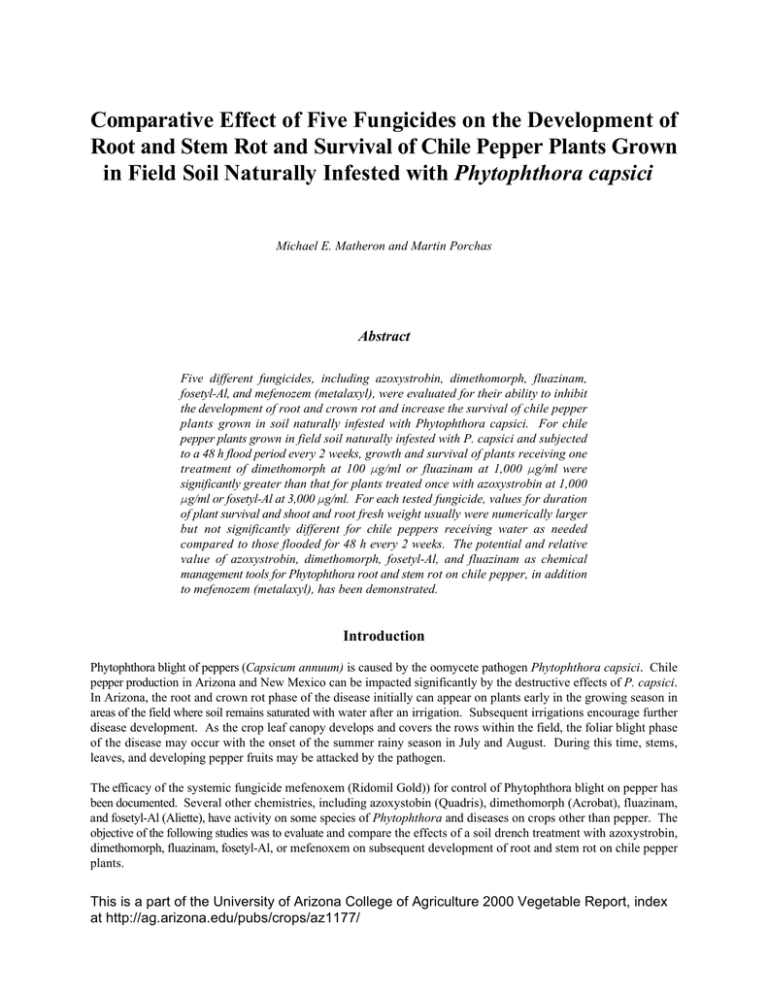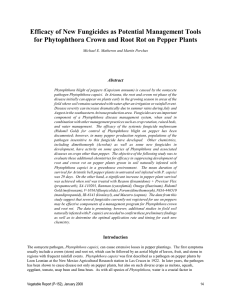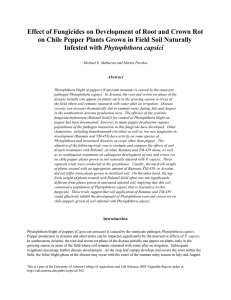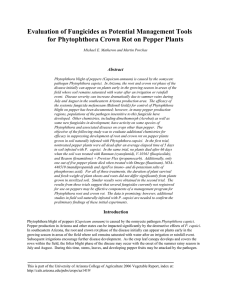Comparative Effect of Five Fungicides on the Development of
advertisement

Comparative Effect of Five Fungicides on the Development of Root and Stem Rot and Survival of Chile Pepper Plants Grown in Field Soil Naturally Infested with Phytophthora capsici Michael E. Matheron and Martin Porchas Abstract Five different fungicides, including azoxystrobin, dimethomorph, fluazinam, fosetyl-Al, and mefenozem (metalaxyl), were evaluated for their ability to inhibit the development of root and crown rot and increase the survival of chile pepper plants grown in soil naturally infested with Phytophthora capsici. For chile pepper plants grown in field soil naturally infested with P. capsici and subjected to a 48 h flood period every 2 weeks, growth and survival of plants receiving one treatment of dimethomorph at 100 Fg/ml or fluazinam at 1,000 Fg/ml were significantly greater than that for plants treated once with azoxystrobin at 1,000 Fg/ml or fosetyl-Al at 3,000 Fg/ml. For each tested fungicide, values for duration of plant survival and shoot and root fresh weight usually were numerically larger but not significantly different for chile peppers receiving water as needed compared to those flooded for 48 h every 2 weeks. The potential and relative value of azoxystrobin, dimethomorph, fosetyl-Al, and fluazinam as chemical management tools for Phytophthora root and stem rot on chile pepper, in addition to mefenozem (metalaxyl), has been demonstrated. Introduction Phytophthora blight of peppers (Capsicum annuum) is caused by the oomycete pathogen Phytophthora capsici. Chile pepper production in Arizona and New Mexico can be impacted significantly by the destructive effects of P. capsici. In Arizona, the root and crown rot phase of the disease initially can appear on plants early in the growing season in areas of the field where soil remains saturated with water after an irrigation. Subsequent irrigations encourage further disease development. As the crop leaf canopy develops and covers the rows within the field, the foliar blight phase of the disease may occur with the onset of the summer rainy season in July and August. During this time, stems, leaves, and developing pepper fruits may be attacked by the pathogen. The efficacy of the systemic fungicide mefenoxem (Ridomil Gold)) for control of Phytophthora blight on pepper has been documented. Several other chemistries, including azoxystobin (Quadris), dimethomorph (Acrobat), fluazinam, and fosetyl-Al (Aliette), have activity on some species of Phytophthora and diseases on crops other than pepper. The objective of the following studies was to evaluate and compare the effects of a soil drench treatment with azoxystrobin, dimethomorph, fluazinam, fosetyl-Al, or mefenoxem on subsequent development of root and stem rot on chile pepper plants. This is a part of the University of Arizona College of Agriculture 2000 Vegetable Report, index at http://ag.arizona.edu/pubs/crops/az1177/ Materials and Methods A clay loam soil from a field containing chile pepper plants with symptoms of root and stem rot was collected and thoroughly mixed, then distributed into a series of 10-cm-diameter x 10-cm-deep plastic pots. After a 2-mo-old Anaheim TMR 23 pepper plant was planted in each pot, the soil was drenched with 300 ml of a solution containing 1,000 Fg/ml of azoxystrobin, 100 Fg/ml of dimethomorph, 3,000 Fg/ml of fosetyl-Al, 1,000 Fg/m of fluazinam, or 100 Fg/ml of mefenozem. Ten replicate plants were treated with each fungicide. Control plants were treated with water only. A noninfested control treatment was established by planting seedlings in field soil that had been heat sterilized (121EC, 102 kPa, 60 min). For each treatment, five plants were watered as needed (usually every 2 days) for the duration of the trial, whereas the other five plants were watered as needed except for a 48 h period every 2 weeks when the soil in each pot was flooded. Plants were maintained in the greenhouse for the duration of the trial. During the course of the study, the date was recorded when a plant wilted permanently due to disease development. The experiment was terminated after approximately 3 months, when final disease severity was determined by measuring the fresh weights of pepper plant shoots and roots. Infection by P. capsici was confirmed by reisolating the pathogen from infected plants. This experiment was conducted twice. The mean temperature of the soil in the pots during these tests was 20EC, with average low and high daily temperatures of 9EC and 30EC, respectively. Results and Discussion For chile pepper plants grown in field soil naturally infested with P. capsici and subjected to a 48 h flood period every 2 weeks, the duration of plant survival and shoot and root fresh weight were significantly greater for plants receiving one treatment of dimethomorph at 100 Fg/ml or fluazinam at 1,000 Fg/ml when compared to those treated once with azoxystrobin at 1,000 Fg/ml or fosetyl-Al at 3,000 Fg/ml. Plant survival and root fresh weight values for chile pepper plants grown in soil treated with mefenozem at 100 Fg/ml were significantly greater than that recorded in soil treated with fosetyl-Al at 3,000 Fg/ml and significantly less than that recorded in soil treated with dimethomorph at 100 Fg/ml. On the other hand, shoot fresh weight for plants treated with dimenthomorph and mefenozem were not significantly different from each other; however, both treatments were significantly greater than fosetyl-Al. When chile pepper plants were grown in field soil naturally infested with P. capsici and watered as needed, the duration of plant survival and shoot and root fresh weight were not significantly different between a soil treatment with dimethomorph at 100 Fg/ml, fluazinam at 1,000 Fg/ml and mefenozem at 100 Fg/ml. Plant survival and shoot fresh weight values for all three of these fungicides did not differ significantly from those recorded for chile peppers grown in sterilized field soil. For each tested fungicide, values for duration of plant survival and shoot and root fresh weight usually were numerically larger but not significantly different for chile peppers receiving water as needed compared to those flooded for 48 h every 2 weeks. The comparative efficacy of azoxystrobin, dimethomorph, fosetyl-Al, and fluazinam as potential chemical management tools for Phytophthora root and stem rot of chile pepper plants has been demonstrated. Increased efficacy could be achieved by multiple applications of materials during plant growth and maturation; whereas in this study only one application of each compound was made at the beginning of the 3-month trial. Whether or not any of these compounds ever becomes available to pepper growers will depend on the willingness of the manufacturers to conduct additional studies and to pursue registration. Table 1. Chile pepper Phytophthora root and stem rot fungicide trial. Michael Matheron and Martin Porchas, Yuma Agricultural Center, University of Arizona Treatment Duration of plant survival* Fresh weight (g) Shoot Root Plants flooded for 48 hours every 2 weeks Sterilized soil 62.0 f ** 18.2 g 22.4 i Dimethomorph at 100 Fg/ml 62.0 f 13.6 c-f 19.0 hi Fluazinam at 1,000 Fg/ml 58.8 ef 14.3 e-g 18.9 hi Mefenoxem at 100 Fg/ml 49.8 c-e 9.6 bc 13.5 fg Azoxystrobin at 1,000 Fg/ml 45.3 c 7.7 b 8.5 c-e Fosetyl-Al at 3,000 Fg/ml 27.2 b 3.3 a 6.4 a-c 9.2 a 1.4 a 3.4 ab Nonsterilized soil Plants watered as needed (every 2 days) Sterilized soil 62.0 f 17.5 fg 15.4 gh Dimethomorph at 100 Fg/ml 62.0 f 15.1 fg 10.5 c-f Mefenoxem at 100 Fg/ml 58.7 ef 13.9 d-f 11.3 d-g Fluazinam at 1,000 Fg/ml 56.9 d-f 14.3 d-g 11.8 e-g Azoxystrobin at 1,000 Fg/ml 49.3 cd 10.0 b-e 7.5 b-d Fosetyl-Al at 3,000 Fg/ml 47.8 cd 10.2 b-d 7.5 b-d Nonsterilized soil 16.4 a 2.2 a 3.1 a 4.1 4.2 Least Significant Difference (LSD, P = 0.05) 9.4 * Plants were considered dead when leaves wilted permanently. ** Numbers in each column followed by a different letter are significantly different (P = 0.05) according to the Duncan-Waller k-ratio (LSD) test.









